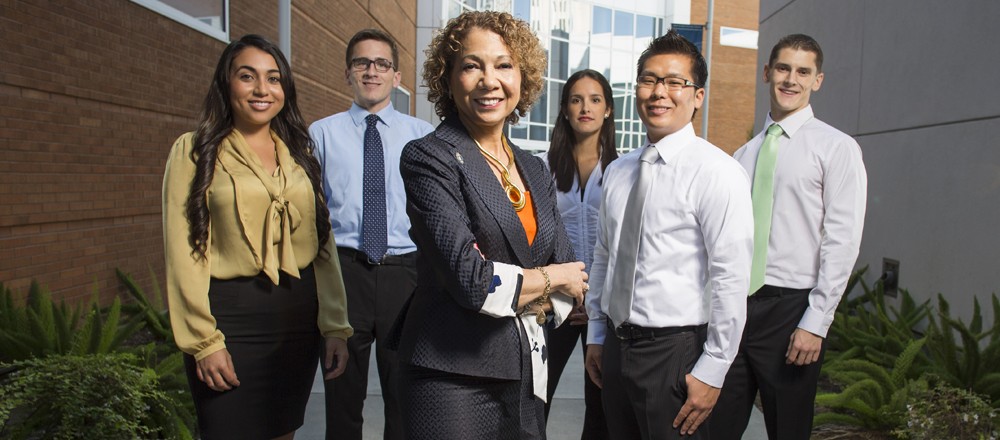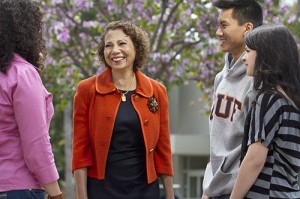Bien Hecho: Latina Overachiever Becomes a College President

 By Ricardo Chavira, LIN@R
By Ricardo Chavira, LIN@R
For Mildred Garcia it also meant the special challenge of “being seen as the other,” the innately less capable “outsider.” (Writer Edward Said popularized the term “outsider” to describe Europeans’ sense of superiority compared to Middle Eastern Orientals.)
She overcame that insidious barrier as do so many people of color, she reflected in a recent interview. “It means making sure that you published more, researched more—basically being an overachiever,” said the new Cal State Fullerton president.
 Starting out in 1974 as an instructor at LaGuardia Community College in Long Island City, NY . Garcia a few years ago finally joined a microscopic minority: Latino presidents. A mere 3.8 percent of American university presidents are Latino, a recent survey, according to a 2011 survey by the American Council on Education Named Cal State Dominguez Hills president in 2007, she became the first Latina to hold that post in the country’s largest state university system.
Starting out in 1974 as an instructor at LaGuardia Community College in Long Island City, NY . Garcia a few years ago finally joined a microscopic minority: Latino presidents. A mere 3.8 percent of American university presidents are Latino, a recent survey, according to a 2011 survey by the American Council on Education Named Cal State Dominguez Hills president in 2007, she became the first Latina to hold that post in the country’s largest state university system.
In June, Garcia, a Brooklyn native, took on her third presidential post, the top job at Cal State Fullerton (CSUF) in Orange County. CSUF, with some 37,000 students, is among the largest of the Cal State campuses.
It is also among the most diverse, with Latinos representing some 32 percent of the student body. The percentage of Latinos in California is 38.1 percent, according to the U.S. Census Bureau. Perhaps not surprisingly, Fullerton ranks fifth nationally in the awarding of bachelor’s degrees to Latinos.
 However, there’s one number that deeply troubles Garcia, and it’s one she’s determined to change. Just 50 percent of all first-time, full-time freshmen graduate in six years.
However, there’s one number that deeply troubles Garcia, and it’s one she’s determined to change. Just 50 percent of all first-time, full-time freshmen graduate in six years.
“That’s a mean that’s unacceptable,” said Garcia. “Fifty percent of our students are not reaching their dreams.”
Plainly, she adds, the university must do a much better job of getting the graduation rate closer to 67 percent, a level more in keeping with institutions similar to CSUF nationally.
Achieving that goal means seeing to it that faculty and administration are far more diverse. Even a casual observer can see that diversity is in short supply. While no campus statistics are available, a recent news story found that system-wide the percentage of Latino faculty had inched up from 6 percent in 1997 to just 8 percent in 2007.
Garcia is tireless in her advocacy of diversity, invariably underscoring its importance in campus and community talks.
“It’s not only the right thing, it’s an economic and civic issue,” she said. “You have to prepare students to live in a global society,” said. Garcia.
Making diversity a reality is no easy task, she agrees.
“You have to educate people…You have to walk the talk,” . Garcia observed, noting her two most recent senior appointments.
The new vice president for student affairs is Berenecea Johnson, an African-American, and Jose Cruz, vice president at the Education Trust, will soon (Dec. 3rd) step into the position of vice president for academic affairs and provost. Both positions had been occupied by white males.
Garcia is universally described as warm, engaging and exceptionally plain-spoken.
Even in a brief conversation, it is quickly apparent that she treasures her parents and working-class upbringing in Brooklyn.
Leopoldo Garcia and Lucia Rivera moved from Puerto Rico to work in the factories near the tenement where they would raise their seventh– Mildred Garcia was the second youngest.
Her parents were her role models.
Leopoldo, with just an eighth-grade education, held a leadership position in the Culebra association. The group aided other arrivals from the Puerto Rican city in finding jobs, housing and schools.
Puerto Ricans from the island formed associations based on their hometowns. This is also common among Mexican immigrants, who form hometown or home state groups.
The association goals were to preserve a sense of community in a new country, help new arrivals get settled and maintain links to the place of origin. Leopoldo was from Culebra, Puerto Rico.
“He was very smart,” recalled Garcia, noting that he not only aided paisanos in transitioning to New York, he also made time to help her with geometry homework.
When Mildred Garcia was 12, Leopoldo died after suffering a heart attack. Lucia singlehandedly took over the job of rearing a large family on the modest earnings factory work provided.
Garcia calls her mother “my hero.” Lucia worked long hours in a factory, all the while encouraging her daughter to further her education. For Garcia, that meant working more than one job to put herself through college.
Her formative years in Brooklyn likely are what drew her to CSUF, what. Garcia calls “a laboratory of diversity.”
She added: “I love telling the story of the students who come to our institution. Many come from a lower socio-economic stratum. They want to do great things for themselves, their families and their communities.”
Garcia was the only one of her siblings to earn a college degree. In a 2007 interview she said, “I was a first-generation student from a very humble background. I have always wanted to give back to communities like the one I grew up in, to help others have the advantages I have been able to have in my life.”
Garcia’s challenge and intended legacy is making sure they achieve those dreams.
This article was first published in LIN@R.
Ricardo Chavira is a lecturer at the University of California, Irvine’s School of Social Science. He teaches media writing, U.S.-Mexico Border Perspective and Mexican Politics. Chavira has taught journalism and mass communication at Cal State Fullerton’s College of Communication since 2004. He has worked as a professional journalist for almost 30 years.
[Photos courtesy LIN@R]
